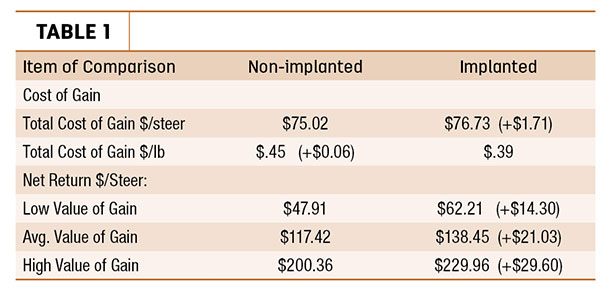A surprising number of producers are choosing to make a lower return on investment simply by not implementing everything available and affordable to them.
Common misconceptions
Although producers seem comfortable with using certain technologies like vaccines, mineral supplementation and even monensin, there is evidence that the number of stocker operators using implants is declining.
Whether producers are avoiding these technologies in a concerted attempt to market or promote their product as “natural,” believe they will get a premium at the sale barn for unimplanted calves or because they have a negative bias against implants is unclear.
Ryan Reuter of Oklahoma State University says, “Some producers think they’ll get more money for their calves at the sale barn if they are ‘natural’; this misconception highlights the value of this kind of research. Although some natural marketing streams may provide a premium, there’s no premium at the sale barn for this.”
Producers may not realize how much implants have benefited them in terms of additional gains. “It’s hard to recognize the missed opportunity for additional gains; you don’t miss what you never had,” says Reuter.
Gary Watkins runs 500 stockers in Boone County, northern Arkansas, and has used both implants and monensin for several years. He actually started using implants before monensin.

Watkins says, “I use it because of the increased weight gain; they [the calves] straighten up better. It helps muscle development, and the cattle just look better quicker. Some producers don’t use the products because they can’t see the benefit; it doesn’t show up if you don’t have very good records.
It’s just like feeding mineral or anything else; they just have never embraced that technology. They don’t study the science. Some people feel like their calves will be discounted if they’ve been implanted, but mostly it is they’ve never tried it, and nothing has convinced them to spend the 2 bucks to do it.”
Brandon Wren, stocker cattle producer near Texarkana, Arkansas, uses all available technologies in a receiving protocol, including castration, vaccination, deworming, monensin-containing mineral and growth-promoting implants.
“For every $1 I invest, I get a return of $20; it’s easy math. There’s too much gamble involved for me to go all-natural.” Wren grazes cool-season pasture and supplements a monensin-containing mineral.
Research backs it up
Growth-promoting implants have been shown to increase gains of grazing calves by 10 to 30 percent. Implants function by supplying very small amounts of compounds that act like naturally occurring hormones. As a result, they increase lean muscle growth and decrease fat deposition.
Fat requires more energy than lean muscle to form, and as a result of using implants, gains and feed efficiency are increased.
Although 90 percent of finishing operations in the U.S. use growth-promoting implants, the adoption rate in stocker operations is much lower. Estimates are that 78 percent of larger stocker operations use this technology, while only about 60 percent of smaller operations do.
Another technology that increases growing cattle performance is the inclusion of monensin in supplements. Gerald Horn of Oklahoma State University conducted research that showed daily gains of cattle grazing wheat pasture increased by nearly 0.2 of a pound.
Studies conducted in Arkansas, Oklahoma and Texas tested these technologies in tandem to determine if the effect of their use is additive in nature.
There may be some skepticism among producers, consultants and others that utilizing both implants and monensin would result in enhanced animal performance comparable to the results of using each technology alone. Reuter says, “The assumption was that these technologies complement each other, and we wanted to conduct research to confirm that.”
Paul Beck of the University of Arkansas conducted research on wheat pasture comparing implanted steers supplemented with a monensin-containing mineral supplement to non-implanted steers on a mineral lacking monensin.
He found the total cost of gain to be less for steers supplemented with monensin compared with the control steers. Furthermore, even though implanting increased the total cost of gain per steer, the cost per pound of gain was 13 percent less for implanted steers than for non-implanted steers.
Research conducted at the Noble Foundation in Ardmore, Oklahoma, evaluated how growth-promoting implants and monensin affect performance when used simultaneously. Steers weighed around 550 pounds; some were implanted with trenbolone acetate-estradiol and some were not.
They grazed cereal rye pasture for 84 days and, during that time, were supplemented with white salt blocks, non-medicated mineral blocks or mineral blocks containing monensin. In this study, implanting increased average daily gain by 22.3 percent, or 2.54 pounds per day, compared to 2.07 pounds per day for the non-implanted group.
Steers fed monensin gained 17.7 percent faster than steers fed salt only (2.49 pounds per day compared to only 2.12 pounds per day for the salt-only group). Steers fed the non-medicated mineral blocks were between these two groups, gaining 2.32 pounds per day.
The take-home from this study is: These technologies are additive in nature, meaning their use works in different modes of action and they complement each other to improve performance.
Researchers at Oklahoma State University, led by Gerald Horn, also found that these technologies work independent of one another and therefore have an additive effect on animal performance.
They concluded that supplementation with monensin in combination with an implant improved average daily gain without having a negative effect on finishing performance or carcass quality.
A lot of producers assume that since gains on summer grass are lower, the response to growth-promoting technologies is lower so these technologies don’t pay on summer grazing, but research at the University of Arkansas Southwest Research and Extension Center at Hope, conducted by Paul Beck, indicates the opposite is true.
Beck says, “The response to the ionophores on summer grass is equal to what you would expect on cool-season annuals, as is the response to implants. Heifers grazing bermudagrass had increased gains of 0.2 pounds per day, over the non-implanted control, which is similar to the response you could expect on cool-season annuals."
"In another study, implanting steers increased from 1.4 to 1.7 pounds per day, which is over 20 percent improvement in performance. The response, as a percent of base-gain, is greater with lower-quality forages than what we would see with high-quality cool-season pastures, indicating an even greater potential for economic benefit.”
“People just need to read the science behind these products; there’s enough data out there now that as producers, we don’t always pay attention to the knowledge available to us. Take monensin, for example; it has the added advantage of being a coccidiostat, and as producers we should utilize the science,” Watkins says.
We’re back to the original question. Are you willing to spend a buck to make $20? ![]()
PHOTO: Implanting growing calves can increase gains by 0.2 of a pound. Photo by Melissa Beck.

-
Melissa Beck.
- Freelance Writer
- Prescott, Arkansas
- Email Melissa Beck.








